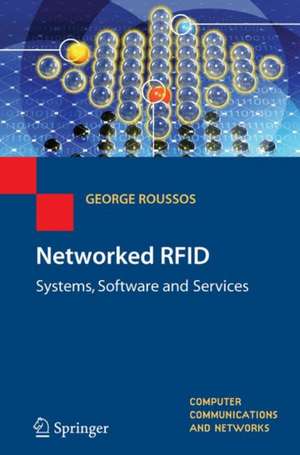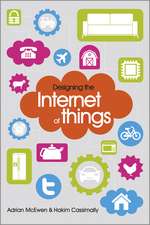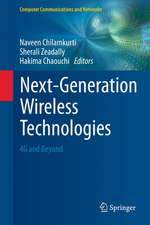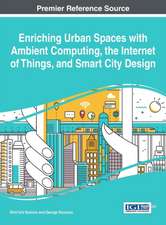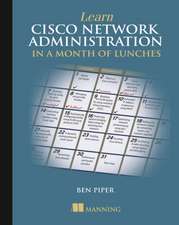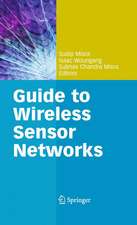Networked RFID: Systems, Software and Services: Computer Communications and Networks
Autor George Roussosen Limba Engleză Paperback – 25 aug 2008
Din seria Computer Communications and Networks
- 20%
 Preț: 378.19 lei
Preț: 378.19 lei - 20%
 Preț: 684.74 lei
Preț: 684.74 lei - 20%
 Preț: 218.22 lei
Preț: 218.22 lei - 20%
 Preț: 1013.39 lei
Preț: 1013.39 lei - 20%
 Preț: 368.78 lei
Preț: 368.78 lei - 20%
 Preț: 505.49 lei
Preț: 505.49 lei - 20%
 Preț: 646.80 lei
Preț: 646.80 lei - 20%
 Preț: 609.09 lei
Preț: 609.09 lei - 20%
 Preț: 765.60 lei
Preț: 765.60 lei - 20%
 Preț: 339.47 lei
Preț: 339.47 lei - 20%
 Preț: 597.29 lei
Preț: 597.29 lei - 20%
 Preț: 655.85 lei
Preț: 655.85 lei - 20%
 Preț: 997.06 lei
Preț: 997.06 lei - 20%
 Preț: 351.89 lei
Preț: 351.89 lei - 20%
 Preț: 902.04 lei
Preț: 902.04 lei - 20%
 Preț: 996.22 lei
Preț: 996.22 lei - 20%
 Preț: 644.81 lei
Preț: 644.81 lei - 15%
 Preț: 650.69 lei
Preț: 650.69 lei - 20%
 Preț: 650.73 lei
Preț: 650.73 lei - 20%
 Preț: 373.91 lei
Preț: 373.91 lei - 20%
 Preț: 646.95 lei
Preț: 646.95 lei - 20%
 Preț: 1004.99 lei
Preț: 1004.99 lei - 20%
 Preț: 646.80 lei
Preț: 646.80 lei - 20%
 Preț: 341.81 lei
Preț: 341.81 lei - 20%
 Preț: 656.19 lei
Preț: 656.19 lei - 20%
 Preț: 651.75 lei
Preț: 651.75 lei - 20%
 Preț: 331.08 lei
Preț: 331.08 lei - 20%
 Preț: 650.40 lei
Preț: 650.40 lei - 20%
 Preț: 988.66 lei
Preț: 988.66 lei - 20%
 Preț: 643.97 lei
Preț: 643.97 lei - 20%
 Preț: 761.44 lei
Preț: 761.44 lei - 20%
 Preț: 332.71 lei
Preț: 332.71 lei - 20%
 Preț: 345.59 lei
Preț: 345.59 lei - 20%
 Preț: 332.06 lei
Preț: 332.06 lei - 20%
 Preț: 996.22 lei
Preț: 996.22 lei - 20%
 Preț: 644.15 lei
Preț: 644.15 lei - 20%
 Preț: 326.64 lei
Preț: 326.64 lei - 20%
 Preț: 320.19 lei
Preț: 320.19 lei - 20%
 Preț: 1013.06 lei
Preț: 1013.06 lei - 20%
 Preț: 642.52 lei
Preț: 642.52 lei - 20%
 Preț: 718.56 lei
Preț: 718.56 lei - 20%
 Preț: 1043.41 lei
Preț: 1043.41 lei
Preț: 641.01 lei
Preț vechi: 801.27 lei
-20% Nou
Puncte Express: 962
Preț estimativ în valută:
122.67€ • 127.60$ • 101.27£
122.67€ • 127.60$ • 101.27£
Carte tipărită la comandă
Livrare economică 14-28 aprilie
Preluare comenzi: 021 569.72.76
Specificații
ISBN-13: 9781848001527
ISBN-10: 1848001525
Pagini: 204
Ilustrații: XVI, 187 p. With online files/update.
Dimensiuni: 155 x 235 x 11 mm
Greutate: 0.3 kg
Ediția:2008
Editura: SPRINGER LONDON
Colecția Springer
Seria Computer Communications and Networks
Locul publicării:London, United Kingdom
ISBN-10: 1848001525
Pagini: 204
Ilustrații: XVI, 187 p. With online files/update.
Dimensiuni: 155 x 235 x 11 mm
Greutate: 0.3 kg
Ediția:2008
Editura: SPRINGER LONDON
Colecția Springer
Seria Computer Communications and Networks
Locul publicării:London, United Kingdom
Public țintă
Professional/practitionerCuprins
What is RFID.- RFID Applications.- Readers and Tags.- Physics and Lower Layers.- Identifier Systems.- System Architectures for RFID.- RFID Middleware.- Network Services.- Privacy and Security.- Epilogue.
Recenzii
From the reviews:
"Radio frequency identification (RFID) is now being accepted by the business community, despite the fact that it still has its challenges. … It is important for engineers to know about this technology, its implementation, and problems presented by RFID. This book promises to fill this gap and it does so quite successfully. … If you are new to RFID technology, this book may be a good start as an overview. Engineers will like this book. It is highly recommended." (Arun Ektare, ACM Computing Reviews, December, 2008)
"Radio frequency identification (RFID) is now being accepted by the business community, despite the fact that it still has its challenges. … It is important for engineers to know about this technology, its implementation, and problems presented by RFID. This book promises to fill this gap and it does so quite successfully. … If you are new to RFID technology, this book may be a good start as an overview. Engineers will like this book. It is highly recommended." (Arun Ektare, ACM Computing Reviews, December, 2008)
Textul de pe ultima copertă
RFID technology has been available for decades, but it is only recently that its application has become a core topic for computing. This book introduces the technologies and techniques of large-scale RFID-enabled mobile computing systems, set in the context of specific case studies.
The book begins with a quick introduction to RFID basics and then discusses the various elements of the topic, using applications such as e-passports, ticketing and supply-chain management throughout. The text explores RFID technology fundamentals, including operating principles, core system components and performance trade-offs involved in the selection of specific RFID platforms. The emphasis is on a practical approach, developing an arsenal of techniques and designs that can be mixed and matched to fit the needs of new systems and applications.
Features
• Offers a practical approach, with specific RFID applications providing context for discussion
• Highlights the basics of RFID, including wireless energy transfer and communication by reflection.
• Presents the main ingredients for building complete network RFID systems
• Discusses the different types of readers and tags in detail – making particular reference to common technologies used in real systems
• Explores how the different identifier systems encode unique serial codes for tagged entities, and how codes are assigned to particular organizations
• Describes the structure and functionality of modern RFID systems and middleware
• Considers different types of network services required for RFID support
• Debates the hot topics of privacy and security
• Looks at the future of RFID technology
• Allows readers to experiment via a supplementary website with operational instances of RFID network services: http://www.roussos.eu/rfid
Written for IT professionals as well as students, thiscomprehensive and reader-friendly text discusses the current state-of-the-art in RFID platforms and architecture. It will be invaluable for anyone experienced in software development and involved with RFID technology, and will facilitate informed decision-making.
The book begins with a quick introduction to RFID basics and then discusses the various elements of the topic, using applications such as e-passports, ticketing and supply-chain management throughout. The text explores RFID technology fundamentals, including operating principles, core system components and performance trade-offs involved in the selection of specific RFID platforms. The emphasis is on a practical approach, developing an arsenal of techniques and designs that can be mixed and matched to fit the needs of new systems and applications.
Features
• Offers a practical approach, with specific RFID applications providing context for discussion
• Highlights the basics of RFID, including wireless energy transfer and communication by reflection.
• Presents the main ingredients for building complete network RFID systems
• Discusses the different types of readers and tags in detail – making particular reference to common technologies used in real systems
• Explores how the different identifier systems encode unique serial codes for tagged entities, and how codes are assigned to particular organizations
• Describes the structure and functionality of modern RFID systems and middleware
• Considers different types of network services required for RFID support
• Debates the hot topics of privacy and security
• Looks at the future of RFID technology
• Allows readers to experiment via a supplementary website with operational instances of RFID network services: http://www.roussos.eu/rfid
Written for IT professionals as well as students, thiscomprehensive and reader-friendly text discusses the current state-of-the-art in RFID platforms and architecture. It will be invaluable for anyone experienced in software development and involved with RFID technology, and will facilitate informed decision-making.
Caracteristici
Focuses on network services and IT infrastructure required for the support of RFID technologies Offers a practical approach, with specific RFID applications providing context for discussion, including: RFID passport controls, RFID drug anti-counterfeiting, automobile manufacturing, metropolitan transportation, retail Via web, free access to operational instances of RFID network services discussed, allowing readers to experiment Includes supplementary material: sn.pub/extras
